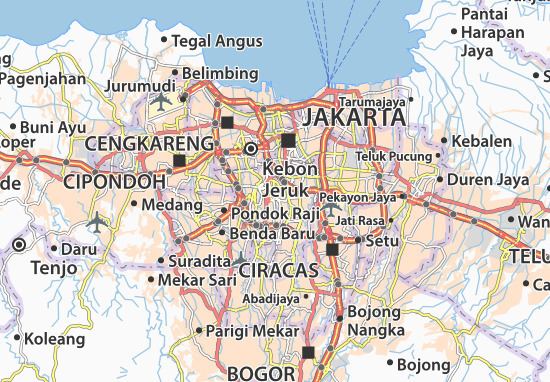 | ||
University Muhammadiyah University of Prof. Dr. HAMKA | ||
Kebayoran Baru is a subdistrict of South Jakarta, Jakarta, Indonesia. Kebayoran Baru was the last residential area to be developed by the Dutch colonial administration. The urban planning was laid in a concept of the Garden city movement, consisting of a well-planned residential area, a shopping center, and a business district, supported with civic facilities e.g. schools, places of worship, hospitals, and parks. Many important governmental institutions are located in Kebayoran Baru, such as the Indonesia Stock Exchange building, the City Hall of South Jakarta, and the ASEAN Secretariat building.
Contents
- Toponym
- History
- Garden City
- Transportation
- Economy
- Residential district
- Kelurahan Administrative Villages
- List of important places
- Education
- Cited works
- References

The rough boundaries of Kebayoran Baru are Jendral Sudirman Main Road to the northwest, Gatot Subroto Main Road to the northeast, Krukut River to the east, Cipete Utara Road - Haji Nawi Road to the south, and Grogol River to the west.

Toponym

Kebayoran Baru consists of the word Kebayoran (from kabayuran, meaning "stockpiles of bayur wood (Pterospermum javanicum)") and Baru (Indonesian for "new"). Several stockpiles of timber (including bayur wood) were built there in earlier time. Bayur wood is known for its strength and resistance to termite attack.
History

Development of Kebayoran Baru was a relatively quick one. The idea to build a satellite town Kebayoran Baru to accommodate the growing population of Jakarta was launched in 1948; the plan was approved in September 1948, just two months after it was first presented. Immediately thereafter the government began to purchase the land; and by 17 January 1949 the whole area had been purchased. On February 1949, Moh. Soesilo completed the first draft of the town plan and a month later construction work started. Soesilo was a student of Thomas Karsten, a Dutch engineer who gave major contributions to architecture and town planning in Indonesia during the colonial era. Soesilo designed both Kebayoran Baru and Pejompongan in 1948, both are considered to be the first urban center to be designed by an Indonesian.
The first area to be designed is now located around Kebayoran station, on the east side of Grogol River. The construction was done by a Dutch construction company Centrale Stichting Wederopbouw (CSW), whose office was established near the current Attorney General building (Kejaksaan Agung) on June 1, 1948. The construction of Kebayoran Baru was started on March 8, 1949, and was completed in 1955. The office building of CSW was located near the Judicial Palace building (Kejaksaan Agung).
At its completion, Kebayoran Baru was still a satellite city of Jakarta located outside the city boundary. The Thamrin and Sudirman Road were constructed since 1949 to connect Kebayoran Baru with Central Jakarta. It would only be opened in 1953. Access from Central Jakarta to Kebayoran Baru before the completion of the Thamrin and Sudirman Roads were via Jalan Palmerah Utara and Jalan Palmerah Selatan (now Jalan Asia Afrika).
Garden City
Kebayoran Baru is designed following the principle of a garden city.
Kebayoran Baru was divided into several blocks (blok A to S) based on its land use and the size of the building:
Most buildings in Kebayoran Baru were designed following the principle of functionalism, that is making use of the latest building material (reinforced concrete) and taking into consideration the principle of tropical design - to maximize natural lighting while minimizing the heat without the use of electricity. Post-war modernism style e.g. the so-called Yankee-type or Jengki style were popular in Kebayoran Baru, so called because of its heavy influence from the American post-war modernism. For example, middle class houses in Kebayoran were designed with square or rectangular layout, but the first floor is tilted forward to protect the facade of the lower level from the sun. Lower-level official houses in Kebayoran make use of front patio. Larger villas in Kebayoran were usually designed by well-known Indies architects at that time such as Job & Sprey and Liem Bwan Tjie. The current Kebayoran Baru Subdistrict also includes some villages which is not part of the original plan. This additions are now located in Radio area, Gandaria Utara, and Cipete Utara.
Being a design older than 50 years, Kebayoran Baru is considered a cultural heritage (Cagar Budaya) according to Law no. D.IV-6099/d/33/1975. New modern international style developments in the area has been a threat to the historic tropical residential character of Kebayoran Baru.
Transportation
Compared to the situation of subdistricts in Jakarta, Kebayoran Baru is a well-planned subdistrict, both in term of its urban planning and its infrastructure. The Jendral Sudirman main road connects Kebayoran Baru to the city center in Central Jakarta.
The southern quarter of the Semanggi Junction is located in Kebayoran Baru.
Economy
Google Indonesia is based in Kebayoran Baru.
Residential district
Kebayoran Baru is one of the most affluent areas of Jakarta, where many wealthy citizens reside. Many prominent Indonesians live in the district, including Jusuf Kalla (Vice President of Indonesia and business tycoon), Guruh Soekarnoputra (son of Soekarno and an artist), Hary Tanoesoedibjo (Indonesian media tycoon), and Tomy Winata (businessman and the owner of Artha Graha Bank), among others. Kebayoran Baru, along with the subdistrict of Menteng, are the most expensive residential districts in Indonesia, having very high land prices per square foot.
Although Kebayoran Baru, in the Soekarno era, was solely a residential area, the district now harbors many commercial ventures, being known for its lifestyle businesses. The southern part of the neighborhood is filled with large mansions with lots ranging from 500 square meters to 6000 square meters. The northern part of the city is dominated by luxury apartments and office buildings. Senayan is notable for its large concentration of businesses run by Korean expatriates in Indonesia, a trend which began as early as 1982.
Kelurahan (Administrative Villages)
The subdistrict of Kebayoran Baru is divided into ten kelurahan or administrative villages:
